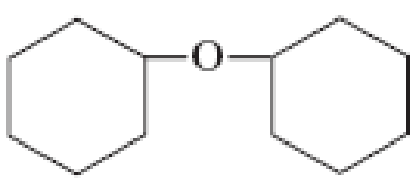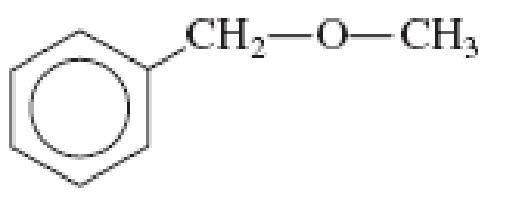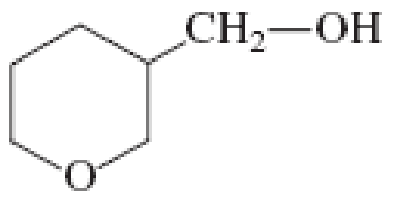
Bundle: General, Organic, and Biological Chemistry, 7th + OWLv2 Quick Prep for General Chemistry, 4 terms (24 months) Printed Access Card
7th Edition
ISBN: 9781305717534
Author: H. Stephen Stoker
Publisher: Cengage Learning
expand_more
expand_more
format_list_bulleted
Textbook Question
Chapter 14, Problem 14.128EP
Classify each of the following molecular structures as that of a cyclic ether, a noncyclic ether, or a nonether.




Expert Solution & Answer
Trending nowThis is a popular solution!

Students have asked these similar questions
You have started a patient on a new drug. Each dose introduces 40 pg/mL of drug after redistribution and prior to elimination. This drug is administered at 24 h intervals and has a half life of 24 h. What will the concentration of drug be after each of the first six doses? Show your work
a. What is the concentration after the first dose? in pg/mL
b. What is the concentration after the second dose? in pg/mL
c. What is the concentration after the third dose? in pg/mL
How many different molecules are drawn below?
Only 100% sure experts solve it correct complete solutions need to get full marks it's my quiz okkkk.take your time but solve full accurate okkk chemistry expert solve it.qno4
Chapter 14 Solutions
Bundle: General, Organic, and Biological Chemistry, 7th + OWLv2 Quick Prep for General Chemistry, 4 terms (24 months) Printed Access Card
Ch. 14.1 - Prob. 1QQCh. 14.1 - Prob. 2QQCh. 14.2 - Prob. 1QQCh. 14.2 - Prob. 2QQCh. 14.2 - Prob. 3QQCh. 14.3 - Prob. 1QQCh. 14.3 - Prob. 2QQCh. 14.3 - Prob. 3QQCh. 14.3 - Prob. 4QQCh. 14.4 - Prob. 1QQ
Ch. 14.4 - Prob. 2QQCh. 14.4 - Prob. 3QQCh. 14.5 - Prob. 1QQCh. 14.5 - Prob. 2QQCh. 14.5 - Prob. 3QQCh. 14.5 - Prob. 4QQCh. 14.6 - Prob. 1QQCh. 14.6 - Prob. 2QQCh. 14.6 - Prob. 3QQCh. 14.7 - Prob. 1QQCh. 14.7 - Prob. 2QQCh. 14.8 - Prob. 1QQCh. 14.8 - Prob. 2QQCh. 14.9 - Prob. 1QQCh. 14.9 - Prob. 2QQCh. 14.9 - Prob. 3QQCh. 14.9 - Prob. 4QQCh. 14.9 - Prob. 5QQCh. 14.9 - Prob. 6QQCh. 14.10 - Prob. 1QQCh. 14.10 - Prob. 2QQCh. 14.11 - Prob. 1QQCh. 14.11 - Prob. 2QQCh. 14.11 - Prob. 3QQCh. 14.12 - Prob. 1QQCh. 14.12 - Prob. 2QQCh. 14.13 - Prob. 1QQCh. 14.13 - Prob. 2QQCh. 14.13 - Prob. 3QQCh. 14.14 - Prob. 1QQCh. 14.14 - Prob. 2QQCh. 14.14 - Prob. 3QQCh. 14.15 - Prob. 1QQCh. 14.15 - Prob. 2QQCh. 14.15 - Prob. 3QQCh. 14.15 - Prob. 4QQCh. 14.16 - Prob. 1QQCh. 14.16 - Prob. 2QQCh. 14.17 - Prob. 1QQCh. 14.17 - Prob. 2QQCh. 14.17 - Prob. 3QQCh. 14.18 - Prob. 1QQCh. 14.18 - Prob. 2QQCh. 14.18 - Prob. 3QQCh. 14.19 - Prob. 1QQCh. 14.19 - Prob. 2QQCh. 14.20 - Prob. 1QQCh. 14.20 - Prob. 2QQCh. 14.20 - Prob. 3QQCh. 14.20 - Prob. 4QQCh. 14.20 - Prob. 5QQCh. 14.21 - Prob. 1QQCh. 14.21 - Prob. 2QQCh. 14.21 - Prob. 3QQCh. 14.21 - Prob. 4QQCh. 14.21 - Prob. 5QQCh. 14 - Prob. 14.1EPCh. 14 - Prob. 14.2EPCh. 14 - Prob. 14.3EPCh. 14 - Prob. 14.4EPCh. 14 - Prob. 14.5EPCh. 14 - Prob. 14.6EPCh. 14 - Prob. 14.7EPCh. 14 - Prob. 14.8EPCh. 14 - Prob. 14.9EPCh. 14 - Prob. 14.10EPCh. 14 - Write a condensed structural formula for each of...Ch. 14 - Write a condensed structural formula for each of...Ch. 14 - Prob. 14.13EPCh. 14 - Prob. 14.14EPCh. 14 - Prob. 14.15EPCh. 14 - Prob. 14.16EPCh. 14 - Prob. 14.17EPCh. 14 - Prob. 14.18EPCh. 14 - Each of the following alcohols is named...Ch. 14 - Prob. 14.20EPCh. 14 - Prob. 14.21EPCh. 14 - Prob. 14.22EPCh. 14 - Prob. 14.23EPCh. 14 - Prob. 14.24EPCh. 14 - Prob. 14.25EPCh. 14 - Prob. 14.26EPCh. 14 - Prob. 14.27EPCh. 14 - Prob. 14.28EPCh. 14 - Prob. 14.29EPCh. 14 - Prob. 14.30EPCh. 14 - Prob. 14.31EPCh. 14 - Prob. 14.32EPCh. 14 - Prob. 14.33EPCh. 14 - Prob. 14.34EPCh. 14 - Explain why the boiling points of alcohols are...Ch. 14 - Explain why the water solubilities of alcohols are...Ch. 14 - Prob. 14.37EPCh. 14 - Prob. 14.38EPCh. 14 - Prob. 14.39EPCh. 14 - Which member of each of the following pairs of...Ch. 14 - Determine the maximum number of hydrogen bonds...Ch. 14 - Determine the maximum number of hydrogen bonds...Ch. 14 - Prob. 14.43EPCh. 14 - Prob. 14.44EPCh. 14 - Prob. 14.45EPCh. 14 - Prob. 14.46EPCh. 14 - Classify each of the following alcohols as a...Ch. 14 - Classify each of the following alcohols as a...Ch. 14 - Classify each of the following alcohols as a...Ch. 14 - Classify each of the following alcohols as a...Ch. 14 - Prob. 14.51EPCh. 14 - Prob. 14.52EPCh. 14 - Prob. 14.53EPCh. 14 - Prob. 14.54EPCh. 14 - Prob. 14.55EPCh. 14 - Prob. 14.56EPCh. 14 - Prob. 14.57EPCh. 14 - Prob. 14.58EPCh. 14 - Prob. 14.59EPCh. 14 - Prob. 14.60EPCh. 14 - The alcohol 2,2-dimethyl-1-butanol cannot be...Ch. 14 - Prob. 14.62EPCh. 14 - Prob. 14.63EPCh. 14 - Prob. 14.64EPCh. 14 - Draw the structure of the aldehyde or ketone...Ch. 14 - Draw the structure of the aldehyde or ketone...Ch. 14 - Prob. 14.67EPCh. 14 - Prob. 14.68EPCh. 14 - Prob. 14.69EPCh. 14 - Prob. 14.70EPCh. 14 - Three isomeric pentanols with unbranched carbon...Ch. 14 - Prob. 14.72EPCh. 14 - Prob. 14.73EPCh. 14 - Prob. 14.74EPCh. 14 - Prob. 14.75EPCh. 14 - Prob. 14.76EPCh. 14 - Prob. 14.77EPCh. 14 - Prob. 14.78EPCh. 14 - Prob. 14.79EPCh. 14 - Prob. 14.80EPCh. 14 - Prob. 14.81EPCh. 14 - Prob. 14.82EPCh. 14 - Prob. 14.83EPCh. 14 - Prob. 14.84EPCh. 14 - Prob. 14.85EPCh. 14 - Prob. 14.86EPCh. 14 - Prob. 14.87EPCh. 14 - Prob. 14.88EPCh. 14 - Prob. 14.89EPCh. 14 - Prob. 14.90EPCh. 14 - Prob. 14.91EPCh. 14 - Classify each of the following compounds as an...Ch. 14 - Draw or write the following for the simplest ether...Ch. 14 - Draw or write the following for the simplest ether...Ch. 14 - Prob. 14.95EPCh. 14 - Prob. 14.96EPCh. 14 - Prob. 14.97EPCh. 14 - Prob. 14.98EPCh. 14 - Prob. 14.99EPCh. 14 - Prob. 14.100EPCh. 14 - Prob. 14.101EPCh. 14 - Prob. 14.102EPCh. 14 - Prob. 14.103EPCh. 14 - Prob. 14.104EPCh. 14 - Prob. 14.105EPCh. 14 - Prob. 14.106EPCh. 14 - Prob. 14.107EPCh. 14 - Prob. 14.108EPCh. 14 - Prob. 14.109EPCh. 14 - Prob. 14.110EPCh. 14 - Prob. 14.111EPCh. 14 - Prob. 14.112EPCh. 14 - Prob. 14.113EPCh. 14 - Give common names for all ethers that are...Ch. 14 - How many isomeric ethers exist when the R groups...Ch. 14 - Prob. 14.116EPCh. 14 - Prob. 14.117EPCh. 14 - Draw condensed structural formulas for the...Ch. 14 - Prob. 14.119EPCh. 14 - Prob. 14.120EPCh. 14 - Prob. 14.121EPCh. 14 - Prob. 14.122EPCh. 14 - Prob. 14.123EPCh. 14 - How do the chemical reactivities of ethers compare...Ch. 14 - Explain why ether molecules cannot hydrogen-bond...Ch. 14 - How many hydrogen bonds can form between a single...Ch. 14 - Classify each of the following molecular...Ch. 14 - Classify each of the following molecular...Ch. 14 - Prob. 14.129EPCh. 14 - Prob. 14.130EPCh. 14 - Prob. 14.131EPCh. 14 - Draw a condensed structural formula for each of...Ch. 14 - Prob. 14.133EPCh. 14 - Prob. 14.134EPCh. 14 - Prob. 14.135EPCh. 14 - Prob. 14.136EPCh. 14 - Prob. 14.137EPCh. 14 - For each of the following pairs of compounds,...Ch. 14 - Assign an IUPAC name to each of the following...Ch. 14 - Prob. 14.140EPCh. 14 - Prob. 14.141EPCh. 14 - Prob. 14.142EPCh. 14 - Prob. 14.143EPCh. 14 - Prob. 14.144EPCh. 14 - Prob. 14.145EPCh. 14 - Prob. 14.146EP
Knowledge Booster
Learn more about
Need a deep-dive on the concept behind this application? Look no further. Learn more about this topic, chemistry and related others by exploring similar questions and additional content below.Similar questions
- Nonearrow_forwardA complete tensile test was performed on a magnesium specimen of 12 mm diameter and 30 mm length, until breaking. The specimen is assumed to maintain a constant volume. Calculate the approximate value of the actual stress at breaking. TABLE. The tensile force F and the length of the specimen are represented for each L until breaking. F/N L/mm 0 30,0000 30,0296 5000 10000 30,0592 15000 30,0888 20000 30,15 25000 30,51 26500 30,90 27000 31,50 26500 32,10 25000 32,79arrow_forwardNonearrow_forward
- Differentiate between plastic deformation, elastic deformation, viscoelastic deformation and viscoplastic deformation.arrow_forward1.57 Draw all reasonable resonance structures for the following cation. Then draw the resonance hybrid.arrow_forwardFor the two questions below, draw the mechanism and form the major product.arrow_forward
- Indicate similarities and differences between natural, exchanged and pillared clays.arrow_forwardShow work. don't give Ai generated solutionarrow_forwardIn intercalation compounds, their sheets can be neutral or have a negative or positive charge, depending on the nature of the incorporated species and its structure. Is this statement correct?arrow_forward
- This thermodynamic cycle describes the formation of an ionic compound MX2 from a metal element M and nonmetal element X in their standard states. What is the lattice enthalpy of MX2 ? What is the enthalpy formation of MX2 ? Suppose both the heat of sublimation of M and the ionization enthalpy of M were smaller. Would MX2 be more stable? Or less? or impossible to tell without more information?arrow_forward7. Draw the mechanism to describe the following transformation: Note: This is a base catalyzed reaction. So, the last steps must make [OH]- OH [OH]¯ OH Heat Oarrow_forwardShow work with explanation...don't give Ai generated solutionarrow_forward
arrow_back_ios
SEE MORE QUESTIONS
arrow_forward_ios
Recommended textbooks for you
 Organic And Biological ChemistryChemistryISBN:9781305081079Author:STOKER, H. Stephen (howard Stephen)Publisher:Cengage Learning,
Organic And Biological ChemistryChemistryISBN:9781305081079Author:STOKER, H. Stephen (howard Stephen)Publisher:Cengage Learning, General, Organic, and Biological ChemistryChemistryISBN:9781285853918Author:H. Stephen StokerPublisher:Cengage Learning
General, Organic, and Biological ChemistryChemistryISBN:9781285853918Author:H. Stephen StokerPublisher:Cengage Learning Chemistry: Principles and PracticeChemistryISBN:9780534420123Author:Daniel L. Reger, Scott R. Goode, David W. Ball, Edward MercerPublisher:Cengage Learning
Chemistry: Principles and PracticeChemistryISBN:9780534420123Author:Daniel L. Reger, Scott R. Goode, David W. Ball, Edward MercerPublisher:Cengage Learning Introductory Chemistry: An Active Learning Approa...ChemistryISBN:9781305079250Author:Mark S. Cracolice, Ed PetersPublisher:Cengage Learning
Introductory Chemistry: An Active Learning Approa...ChemistryISBN:9781305079250Author:Mark S. Cracolice, Ed PetersPublisher:Cengage Learning Chemistry for Today: General, Organic, and Bioche...ChemistryISBN:9781305960060Author:Spencer L. Seager, Michael R. Slabaugh, Maren S. HansenPublisher:Cengage Learning
Chemistry for Today: General, Organic, and Bioche...ChemistryISBN:9781305960060Author:Spencer L. Seager, Michael R. Slabaugh, Maren S. HansenPublisher:Cengage Learning

Organic And Biological Chemistry
Chemistry
ISBN:9781305081079
Author:STOKER, H. Stephen (howard Stephen)
Publisher:Cengage Learning,

General, Organic, and Biological Chemistry
Chemistry
ISBN:9781285853918
Author:H. Stephen Stoker
Publisher:Cengage Learning

Chemistry: Principles and Practice
Chemistry
ISBN:9780534420123
Author:Daniel L. Reger, Scott R. Goode, David W. Ball, Edward Mercer
Publisher:Cengage Learning

Introductory Chemistry: An Active Learning Approa...
Chemistry
ISBN:9781305079250
Author:Mark S. Cracolice, Ed Peters
Publisher:Cengage Learning

Chemistry for Today: General, Organic, and Bioche...
Chemistry
ISBN:9781305960060
Author:Spencer L. Seager, Michael R. Slabaugh, Maren S. Hansen
Publisher:Cengage Learning

07 Physical Properties of Organic Compounds; Author: Mindset;https://www.youtube.com/watch?v=UjlSgwq4w6U;License: Standard YouTube License, CC-BY